The images included in this section use all these methods.
Note that all spiral patterns, circular or not, are found on the
Spiral Patterns page. Also note that all source
documents are listed by author in square brackets, with the full name found
on the Class Bibliography page.
Clip art materials using circular knotwork and keywork patterns are
divided into the following categories:
These images include both horizontal separator "lines" and vertical
backgrounds with left-hand borders. Please click on the bordered thumbnails
to see the full-size images.
Where possible, the components of the borders are provided. That is, the
left edge, the center (middle) repeated section, and the right edge are
provided as separate files. These may be combined to make borders of any
size desired.
1. | |
2. | |
3. |
| These tiles are based on an annular (ring)
pattern found originally on the Lastingham Cross. The
underlying knotwork is from Romilly Allen's "Knot 4" pattern.
The stone cross is shown on [BainI] page 11, while the
pattern is analyzed on [BainI] page 77. Tile 3.a shows
the basic pattern, while 3.b has been modified to make a
continuous pattern when tiled as a page/window
background. |
a.  b.
b. 
| |
4. | |
5. |
| The following panels are based on an adaptation
of a triangular knotwork panel used on the Ulbster
Stone and the Penmon Stone. I found
the original in [BainG] page 47, Plate 5, and [BainI]
page 88. The concept of "circularizing" a
triangular knotwork template is from [BainI] page
92. It is also used as the basis for Circular Knotwork
border 1 on this page. Tile 5.a is rendered as
"embossed paper" while 5.b is rendered as "carved stone". |
a.  b.
b. 
| |
6. |
| The following panels are based on a circular
adaptation of a triangular knotwork pattern found on the
Ulbster Stone, pre-analyzed in [BainG] page 41 Plate
F. The concept of "circularizing" a triangular knotwork
template is from [BainI] page 92. Tile 6.a is based on
the original right triangular pattern, while 6.b is based on
the 60-degree adaptation used on Tile 10 on the
Triangular Knotwork page. |
a.  b.
b. 
| |
7. |
The following tiles are based on a circular
adaptation of a triangular knotwork pattern originally from
the St. Vigean's Stone, found pre-analyzed in [BainG]
page 41 Plate F.7. The concept of "circularizing"
a triangular knotwork template is from [BainI] page 92.
The original triangular versions are found as Tile 3 on
the Triangular Knotwork page.
Tiles 7.a and 7.b use simple dark shades,
while 7.c is rendered as "beaten gold". |
a.  b.
b.  c.
c. 
| |
8. | |
9. | |
10. |
| The following tiles are based on a
roundel from The Book of Kells Folio 29r containing 6 zoomophic
"snakes". I found it pre-analyzed in [BainG] Plate 6. The samples below
include two versions of the pattern, rendered in shades of gray. All include
a small keywork filler so that they tile gracefully. |
a.  b.
b. 
| |
11. | |
12. | |
13. | |
14. | |
15. | |
16. | |
17. |
| Now for something completely different!
These tiles were developed as part of some research I've been doing
on the influence of Northern European/Insular Celtic art on Central
Asian art. The original pattern was taken from what I've called the
Hermitage Inkwell, a bronze inkwell, engraved, inlaid in silver
and copper, made in the 2nd half of 1100s CE, from Northeastern Persia,
currently located in the State Hermitage museum, Saint Petersburg
(inv.IR.1533). I analyzed and developed the underlying knotwork
pattern as part of of this research-the original artifact image was
provided to me by the art historians of the Art and Science Endowment
Trust (ASET) in Berlin, Germany.
The first two tiles show the basic pattern in a square grid, using
simple keywork to fill in the gaps. The last three use a "space filling"
tile, with the last two slightly modified to make continuous knotwork
bands. These are all rendered in shades of gray, and could be
used for web page backgrounds. |
a. 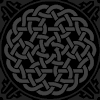 b.
b. 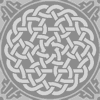 c.
c. 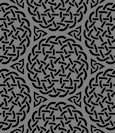 d.
d.  e.
e. 
| |
18. |
| The following tiles use an annular
adaptation of a keywork pattern found at the bottom of Lindifarne
Folio 95r. The repeating, tiled version of the pattern can be found
on the Keywork Designs page.
The first two tiles repeat the basic keywork "phrase" six times and
use a circular knotwork pattern adapted from the Hilton of Cadbol
Stone (see Tile 2 above), while 18.c-d use twelve repeats and use
the full Cadbol pattern (see Tile 15) in the middle. These are
all rendered in shades of gray, and could be used for web page backgrounds.
|
a.  b.
b.  c.
c. 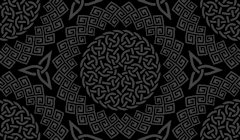 d.
d. 
| |
19. | |
20. |
| These tiles use a pattern taken
from the Book of Durrow, on the "Eagle Evangelist" page,
Folio 94R. It forms the border around the central eagle and has
been adapted to fit an annular space. The regular tiled version can
be found on the Knotwork Designs page.
Tiles 20.a-c use twelve repeats of the basic underlying pattern. All
use the simplified Cadbol Stone knotwork pattern (see Tile 2 above)
to fill in the middle of the annulus. Tiles 20.a-b are rendered in
shades of gray, and could be used for web page backgrounds. TIle 20.c
uses an approximation of the original color scheme adapted to an annular
area. |
a. 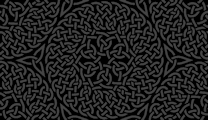 b.
b. 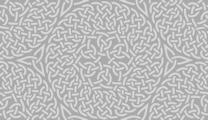 c.
c. 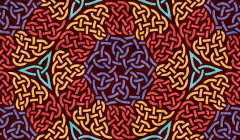
| |
21. |
|
These tiles use a keywork pattern taken from the Book of Kells,
Folio 124r, adapted to fit an annular space. They use a "space filling"
repeat, and use the simplified Cadbol Stone knotwork pattern (see
Tile 2 above) to fill in the middle of the annulus, and are both rendered
in shades of gray. |
a. 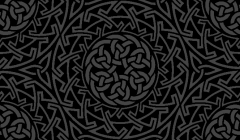 b.
b. 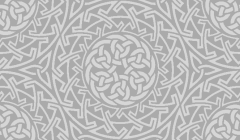
| |
22. |
|
These tiles use a pattern originally found in Kells,
Folio 114v adapted to an annular area, and repeated twelve times around
(for the rectangular pattern, see the Knotwork Designs
page). I found the underlying design in [BainI] page 108. The basic pattern
looks like:  .
The tiles below use a "space filling" repeat, and use a spiral from the
Aberlemno Stone to fill in the middle of the annulus. .
The tiles below use a "space filling" repeat, and use a spiral from the
Aberlemno Stone to fill in the middle of the annulus. |
a. 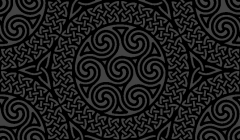 b.
b. 
| |
23. |
|
These tiles use a pattern originally found in a border from the Book of Kells
Folio 29r. The basic pattern looks like:  . These tiles use this pattern adapted to an annular
area, and repeated twelve times around. The tiles below use a "space filling"
repeat, and adapt a spiral pattern from the Aberlemno Stone to fill in the
middle of the annulus. . These tiles use this pattern adapted to an annular
area, and repeated twelve times around. The tiles below use a "space filling"
repeat, and adapt a spiral pattern from the Aberlemno Stone to fill in the
middle of the annulus. |
a. 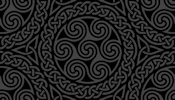 b.
b. 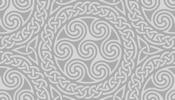
| |
24. | |
25. | |
26. | |
27. |
|
These tiles were also developed as part of some research I've been doing
on the influence of Northern European/Insular Celtic art on Central
Asian art. The original pattern was taken from what I've called the
Nishapur Conical Bowl, a pottery bowl from from Northeastern Iran,
made around the 10th C. and currently in a private collection.
I analyzed and developed the underlying knotwork pattern as part of of
this research. The original artifact image was provided to me by the art
historians of the Art and Science Endowment Trust (ASET) in Berlin, Germany.
The tiles include a simple keywork pattern to fill in the gaps between the
roundels. |
a.  b.
b. 
| |
28. | |
29. |
|
These tiles were developed using a key pattern found on the Rosemarkie
Stone adapted to an annular area (see [BainG] pg. 75 for an example),
and duplicated six times around. They use a "space filling" repeat structure
and use the simplified Cadbol Stone pattern (see Tile 2 above) to fill
in the middle of the annulus. |
a.  b.
b. 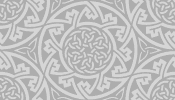
| |
30. |
|
Similar to Tile 29, these were developed using a key pattern found on the
St. Andrews Stone adapted to an annular area (see [BainG] pg. 75 for
an example), and duplicated twelve times around. They also use a "space
filling" repeat structure and adapt the simplified Cadbol Stone
pattern (see Tile 2 above) to fill in the middle of the annulus. |
a. 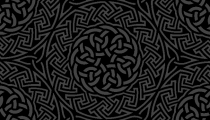 b.
b. 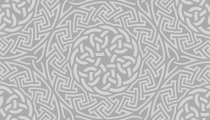
| |
31. |
|
These tiles are based on a triangular knotwork pattern originally on the
Strathmartine Stone. I originally found it in [BainG] page 47 Plate
6. Tiles from this same source can be seen on the
Triangular Knotwork Designs page. These
circular tiles use this pattern adapted to fit in a roundel (this technique
is found in [BainI] page 92). They use a "square" repeat structure
with a simple key pattern used to fill in the spaces between the roundels.
|
a. 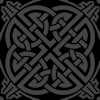 b.
b. 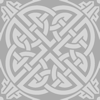
| |
32. |
|
These circular tiles are based on a key pattern from the Dunfallandy
Stone, Fife, adapted to fill a cicular area. It can be found pre-analyzed
in [BainI2], page 7. Tiles from this same source can be seen on the
Triangular Knotwork Designs page. They use
a "space filling" repeat structure, and are rendered in simple gray-scale
shades. |
a.  b.
b. 
| |

